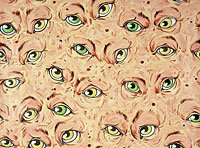Philippe Mayaux
dal 9/5/2007 al 14/8/2007
Segnalato da
9/5/2007
Philippe Mayaux
Centre Pompidou, Paris
The exhibition confirms the originality and great diversity of the artist's work, which, due to the frequent juxtaposition of contraries (war and love, force and fragility) and its often glaring colour and provocative representation of sexual mechanics, can be inscribed in a tradition owing something to both Duchamp and Picabia.

A Mort L'Infini
"The question of painting shouldn't even be posed any longer, nor the question of beauty come to that. When I hear talk of well painted, badly painted, I feel I'm in some dusty craft exhibition in the company of grey-beards, whinging or otherwise."
(Philippe Mayaux in Philippe Mayaux, Semiose/Loevenbruck, Paris, 2006)
Philippe Mayaux, winner of the Marcel Duchamp Prize 2006, is presented in Espace 315 at Centre Pompidou in an exhibition that demonstrates the originality and great diversity of his work. With its often glaring colour and provocative representation of sexual mechanics, his work is inscribed in a tradition that owes something to both Duchamp and Picabia.
Rich in both historical and contemporary references, Philippe Mayaux's work juxtaposes contraries - war and love, force and fragility, the rational and the chimerical. It is in this context of duality and paradoxes that the visitor is invited to traverse the red carpet that leads him through the exhibition that brings together a mix of works, old and new.
Philippe Mayaux's exhibition follows that of other Marcel Duchamp Prize winners, Thomas Hirschhorn (2000-2001), Dominique Gonzalez-Foerster (2002), Mathieu Mercier (2003), Carole Benzaken (2004) and Claude Closky (2005).
Centre Pompidou
Place Georges Pompidou - Paris



